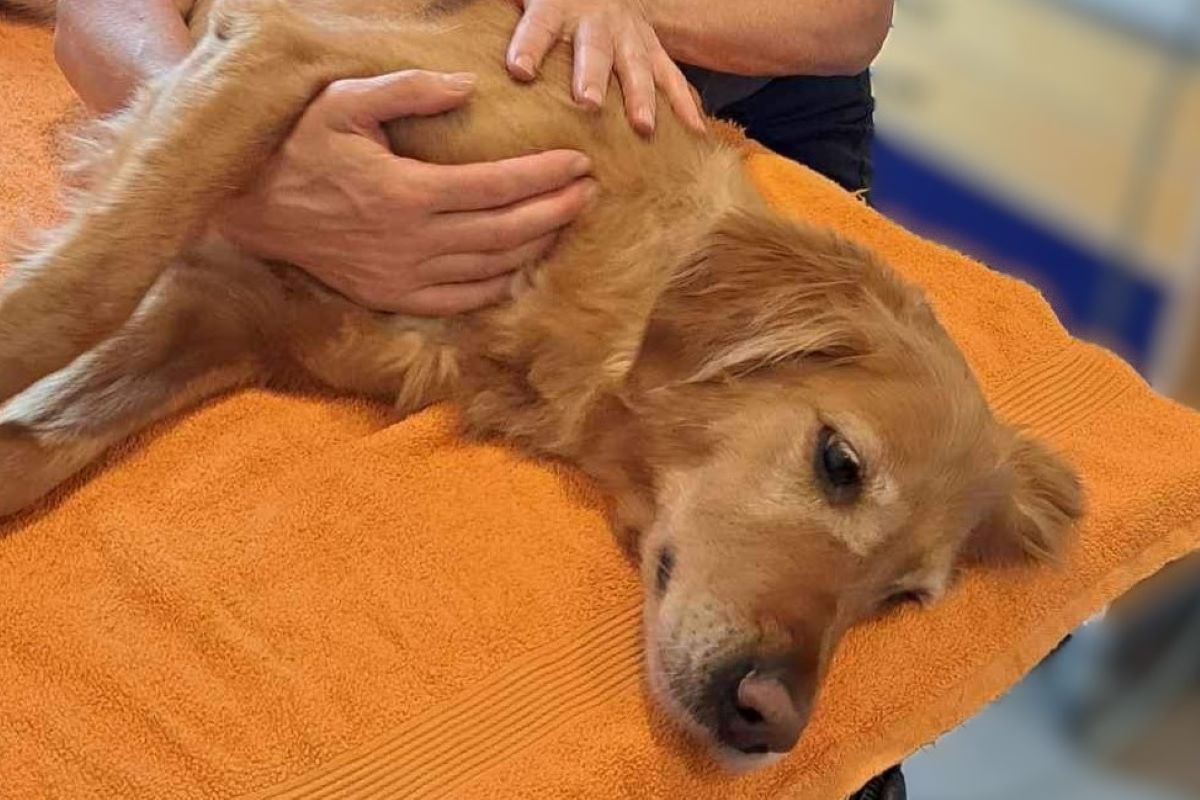How to Calm Your Dog with Gentle Vagus Nerve Stimulation

Introduction
As a physiotherapist for dogs, I’m always looking for gentle, non-invasive ways to help them feel better. One method that has caught my attention is vagus nerve stimulation. It might sound a little technical, but research shows it can help the body relax and support the connection between the heart and the brain. Of course, this is never a substitute for proper veterinary care if your dog shows signs of illness or stress, but it can be a safe addition to their overall wellness routine.
The Role of the Vagus Nerve
The vagus nerve is a major nerve in the body. It starts in the brain, runs down through the neck, and connects to many organs, including the heart, lungs, and stomach. It’s part of what’s often called the “rest and digest” system, which helps the body calm down and recover.
When this nerve is activated, it can send signals that slow the heart rate, deepen breathing, and release tension in the muscles. In people, vagus nerve stimulation is even used as part of certain treatments for anxiety or recovery. In dogs, gentle handling or movement around the neck may also trigger this calming effect.
From my own work, I often see dogs relax completely during neck treatments, almost as if they let go of all their stress in that moment. I’m convinced the vagus nerve plays a role in this response. For me, it’s a clear reminder that physiotherapy isn’t only about movement and mobility — it can also help a dog feel safe, calm, and more connected to the person who cares for them.
What the Science Says (In Dogs)
Early research suggests vagus nerve stimulation really can influence dogs’ bodies in measurable ways:
-
In healthy dogs, a pilot study found that gentle stimulation lowered heart rate and improved signs of relaxation in the nervous system.
-
In dogs with epilepsy, both surgically implanted devices (case study) and non-invasive handheld devices (pilot trial) have helped reduce seizures—sometimes by half or more—while being well tolerated.
These studies are still small, but they show that vagus nerve stimulation can safely affect a dog’s brain and body in ways that support calmness and balance.
What Human Research Adds
Studies in people have shown that gentle, non-invasive vagus nerve stimulation can help the body relax. It can increase heart rate variability (a sign the nervous system is calmer), reduce “fight-or-flight” stress activity, improve sleep in those with insomnia, and even lower the number of migraine attacks. One studyin healthy adults found that it shifted the nervous system away from stress mode and toward relaxation by reducing sympathetic activity.
Since these methods are safe and well-tolerated, it makes sense that similar gentle stimulation could also help dogs feel more relaxed and balanced.
And because these methods are non-invasive and generally well-tolerated, they can be a safe addition to a wellness routine—as long as they’re not used as a substitute for veterinary evaluation when a dog shows unexplained health changes or signs of stress.
What is HRV and Why Does It Matter?
Heart Rate Variability (HRV) is the tiny variation in time between each heartbeat. It’s measured in milliseconds and tells us a lot about how relaxed or stressed the body is.
Higher HRV generally means your (or your dog’s) body is in “rest-and-digest” mode with the parasympathetic nervous system active.
Lower HRV often shows the body is in a “fight-or-flight” state.
Researchers often track HRV to see if a therapy helps the nervous system calm down. In both human and canine studies, vagus nerve stimulation has been linked to increased HRV—a sign of better relaxation and balance.
A Special Experience During Neck Treatments
Over the years, there are treatment sessions I’ll never forget. Sometimes, when I work gently around a dog’s neck — with massage or small movements — something changes. A dog that comes in tense, nervous, even defensive, can suddenly melt into complete relaxation within minutes.
I’ve seen it in dogs that were unsure, frightened, or in pain. A few had even been described as aggressive. And yet in that moment, they let go of all the tension and sank against me with total trust.
Each time I see this happen, I ask myself: What just happened here? How can a dog who was so guarded one moment feel so safe the next?
Often, neither the owner nor the vet can explain these sudden shifts in behaviour. I can’t say for sure either, but I often wonder if it might be linked to the vagus nerve — the long nerve that runs from the brain, down the neck, and into the body, and that plays such an important role in calming the nervous system.

Gentle At-Home Stimulation Ideas
1. Calming touch and massage
Gently stroke or massage the area around your dog’s neck, chest, and along the jugular groove (the soft area beside the windpipe). Use slow, light movements—no pressing. This area lies close to the vagus nerve’s path, and calm touch here may help signal the nervous system to relax.
2. Encourage relaxed breathing
After a walk, training session, or play, sit with your dog in a quiet spot. Keep your own breathing slow and steady—dogs often mirror our breathing rate. You can place a hand gently on their chest to feel the rhythm. Over time, this can encourage a shift from alert to calm.
3. Safe chewing or sniffing games
Offer a safe chew toy or a stuffed treat toy. Chewing activates parts of the nervous system linked to relaxation. Sniffing games—like hiding treats around a room—also promote a calm, focused state that taps into the parasympathetic system.
4. Comfort and routine
Dogs thrive on predictability. Simple rituals, like a set bedtime routine or a short evening cuddle session, provide a sense of safety. That stability helps keep the nervous system balanced and ready to recover after stress.
A Simple 5-Minute Routine to Try
If you want to bring these ideas together, here’s a quick at-home practice:
-
Set the scene: Choose a quiet place without distractions.
-
Begin with touch: Spend 1–2 minutes gently massaging your dog’s neck and chest.
-
Shift to breathing: Match your own breathing to a slow, steady pace and sit close so your dog can feel your calm energy.
-
Add a chew or sniff activity: Offer a safe chew or hide 2–3 small treats for them to find.
-
Close with comfort: End with soft praise and a cuddle before returning to normal activity.
Doing this regularly can help your dog associate these gentle activities with feeling calm and secure.

Another Gentle Option for Supporting Relaxation
Some dog owners are curious whether essential oils—especially lavender—can help their dogs relax. Lavender is one of the few essential oils that has actually been studied in dogs, and early research suggests it may have calming effects. Just like vagus nerve stimulation, it seems to support the parasympathetic (“rest and digest”) system. However, essential oils should always be used with caution.
What Does the Science Say?
-
A 2009 veterinary study found that applying diluted lavender oil to dogs’ inner ears lowered heart rate and increased high-frequency power in heart rate variability (HRV)—a sign of increased vagal (parasympathetic) activity and relaxation.
-
A 2024 study reported that lavender aromatherapy reduced signs of tension in dogs during short-term veterinary stays.
These studies are promising but still limited, so lavender should be seen as a gentle complement—not a replacement for veterinary care.
Safe Use Tips
If you decide to try lavender aromatherapy with your dog:
-
Best method: Use a diffuser with just 1–2 drops in a well-ventilated room. Always let your dog leave the space if they choose.
-
Never apply directly: Don’t put undiluted essential oil on your dog’s skin or fur.
-
Short sessions: Limit diffuser use to 15–20 minutes at a time.
-
Watch closely: Stop if your dog shows signs of discomfort like drooling, sneezing, coughing, or restlessness.
-
Store safely: Keep essential oils out of reach to avoid ingestion.
- Check with your vet first: Especially for puppies, seniors, pregnant dogs, or those with health conditions.
Disclaimer:
This article is for informational purposes only and does not replace professional veterinary advice. Always consult your veterinarian before trying new treatments or therapies with your dog. The author is not responsible for any adverse effects resulting from the use or misuse of the information provided.
🐾 Keep Your Dog Moving Strong & Injury-Free
💡 Join my mailing list and get expert tips on dog wellness, injury prevention, and fitness—straight to your inbox! Learn how to spot early signs of discomfort, protect your dog’s joints, and build simple daily routines to keep them active for years to come.
- Exclusive articles & early access to new resources
- Simple daily routines to support strength & mobility
- Easy ways to prevent joint issues & movement problems
- Hands-on techniques to keep your dog active with confidence
🐾 Sign up today and start making a difference for your dog’s health and happiness!
Start Your Daily Routines Today!